Delicate Pickled Spruce Tips are a special seasonal treat - preserve them when the spruce trees are budding in spring and you'll have delicious, caper-like pickles to add flavour and interest to cheese platters, sandwiches, or salads. Use them to garnish soups, cocktails, or appetizers or add a zippy mouthful of flavour to any meal. (Skip to recipe.)
I'm always a little late to the party. Here in our yard in the country, the spruce trees are just in full glory of budding spruce tips, though when I drive a half hour east into Edmonton, I see that the spruce tree tips are already grown out into feathery fronds. So if you're in a northern locale or a shaded cooler little microclimate, you may still be able to harvest some of those delectable little spring treats. I find the buds are still tighter on the north sides of my trees. (And if your spruce tip season is done, make sure to bookmark or pin this post so you can get on them first thing next spring - it's so easy to miss their short time to shine.)
You can pick the new buds off the ends of the branches from any spruce, fir, or pine species - they all have the same resiny flavour base with fresh citrusy overtones, though different species will have slightly different flavour profile. (Avoid yew trees, which are poisonous and don't grow in our northern climate anyways.) The common spruce trees growing in forests and yards are the ones easiest to find. Just think - you've got this delicate specialty right at your fingertips! Spruce tips can be picked when still in tight buds covered in their papery casing or once they've opened into lime-green new growth. Older, mature needles can be used in some recipes, though they need to be chopped or steeped, as they are tough.
Spruce tips are super little niblets of health-promoting goodness: they're high in vitamin C (indigenous peoples knew chewing on them prevented scurvy, plus they soothed sore throats and relieved lung congestion). They are a good source of carotenoids and are exceptionally high in magnesium and potassium. Drinking spruce or fir tip infused water is a natural source of electrolytes (much better than commercial sugary, colour-laden electrolyte drinks). Make the fresh or dried tips into a healing tea to drink after the season for fresh tips is over.
Don't be worried that picking the spruce tips will harm the tree - you're actually pruning the tree to produce more tips and be even bushier next year. Just don't pick all the tips off one area of a tree - spread your picking around the tree, and don't pick the top tip off a young spruce tree, as that is the growing leader and may make the tree's future growth misshapen.
Spruce tips are ready for harvesting when the brown papery husks are starting to split and loosen off the new buds at the tips of the branches. But you can also use the more feathery, grown-out tips as long as they're still soft, to chop up and flavour salads like this bright green salad or this citrusy one, or in any recipes with spruce tips that require cooking like in this post. However for pickling the zippy little delights, you'll need to have relatively tight buds.
It's quick and easy to preserve a couple small jars. Then let them age for about a week, and pull them out to add a jolt of flavour to all kinds of meals. Pickled spruce tips are great as a bright and unusual addition to a mixed cheese platter - slice up a selection of different cheeses, add a few handfuls of dried fruits and nuts, and a small dish of the pickled tips. Wow! Their tangy flavour, with hints of piney resin and citrus, are just the foil for rich cheeses.
Do you like olives? Pickles? Capers? Then you'll love pickled spruce tips.
Use them anywhere you'd use capers: garnish the top of a grilled fish fillet (especially nice on salmon); chop them into a tuna salad, egg salad, or potato salad; pop one onto each deviled egg; chop them into green salads or bean salads; mince them into salad dressings; add a couple to a sandwich; float them on a cream soup as a garnish; use a bit of the pickled spruce tip brine in a Caesar cocktail and garnish the drink with a couple of tips; or make a spruce tip martini . . . as you can see - the possibilities for these zippy little pickled buds is endless.
* * * * *
Some other fantastic ways to use spruce tips, both savoury and sweet:
Buttery Sauteed Mushrooms with Spruce Tips and Chives
Spruce Tip Baked Rhubarb Compote over Silky Swedish Cream
Potatoes with Cream and Spruce Tips (Plus How to Make Spruce Tip Salt and Spruce Tip Vinegar)
Roasted Asparagus with Garlic and Spruce Tips
Stuffed Pork Tenderloin with Spruce Tips and Orange Glaze
Green Salad with Spruce Tips - a Springtime Treat
Rhubarb and Spruce Tip Galette
* * * * *
Kitchen Frau Notes: You can use white wine vinegar or apple cider vinegar, or even plain white vinegar if that's all you have.
No need to rinse the spruce tips if you picked them with clean hands and they weren't near a road. If you think they need it though, give them a rinse and drain them well.
The brine makes enough for one jar, with a little bit left over, depending on how tightly you pack the spruce tips. If making more than one jar, fill each jar with the listed ingredients, and multiply the vinegar solution by the amount of jars you're using.
In pickling it is best to use filtered water or distilled water as the chlorine or minerals in some city water or well water can cause pickles to discolour or get soft. If you don't have a filtration system or filtration jug (like a Brita jug) you can purchase jugs of distilled water in the grocery store. If you've made pickles with your tap water before and it is fine, then you won't need to get filtered water.
Processing the pickled spruce tips in a boiling water bath ensures they will keep for several years in a cool dark place. If you are only making one jar and plan to use it up within six months, you can just screw the jar shut and keep it refrigerated, without canning it.
Allow the spruce tips to age for at least a week before using them, so the vinegar can fully pickle the buds.
Pickled Spruce Tips
for each half-pint (250ml) jar:
- 6 whole black peppercorns
- 1 bay leaf
- 1 slice of fresh lemon
- 1 teaspoon sea salt
- 1 heaping cup (250ml) of spruce tips
for the brine (enough for 1 jar):
- ¼ cup (60ml) white wine vinegar
- ¼ cup (60ml) filtered or distilled water
Into each very clean and well-rinsed half-pint (1 cup/250ml) jar, place 6 peppercorns, 1 bay leaf, 1 slice of lemon cut in half. and 1 teaspoon salt. Hold the lemon slice and bay leaf against the side of the jar if you'd like them to show on the outside.
Clean the spruce tips of their brown husks (a bit of a sticky job) and pack them into the jars up to ½ inch (1 cm) from the tops of the jars. Pack them in quite firmly. Put the the vinegar and filtered water into a small saucepan and heat just until boiling. Pour the hot brine over the spruce tips and salt until it is also ½ inch (1cm) from the top of the jar. The spruce tips will turn from bright green to olive green as the brine hits them.
Put the new snap lids for the jars into a pot of simmering water for 5 minutes to soften them. Wipe the top rims of the jars with a clean cloth. Seal the jars with the snap lids and metal screw rings until finger tight.
Lay a clean dishcloth in the bottom of a saucepan that is taller than the jars (the dishcloth keeps the jars from bouncing around in the pot once the water is boiling.) Set the jars onto the dishcloth and fill the saucepan with hot tap water up to the bottom of the metal screw rings. Cover the saucepan with a lid and bring the water to a full boil. Once it boils, turn the heat down a bit to keep the water boiling without boiling over. Start timing for 10 minutes.
Process the jars for 10 minutes, then remove them carefully, using a pot holder or jar clamp, to a clean dishtowel laid out on the counter. Leave the jars undisturbed until they are cool. The metal lids should have sealed and suctioned down. If the lids are still bowed slightly upward, then the jars haven't sealed and should be stored in the fridge and consumed within six months (leave them to age for one month before using). The spruce tips will all have floated to the top of the jars once cool. Give each jar a shake and they will disperse evenly again.
If sealed, the pickled spruce tips will last for several years in a cool, dark place. Leave the jars for a week before using them, so the brine has had time to fully flavour the spruce tips.
Guten Appetit!
Sign up here to receive new Kitchen Frau recipes directly to your email inbox, and get a handy and useful kitchen tip with each recipe.
If you like my recipes, follow me on Instagram, Pinterest, Twitter, and Facebook. You’d make my day!
Don’t forget to PIN IT to save the recipe:
You might also like:


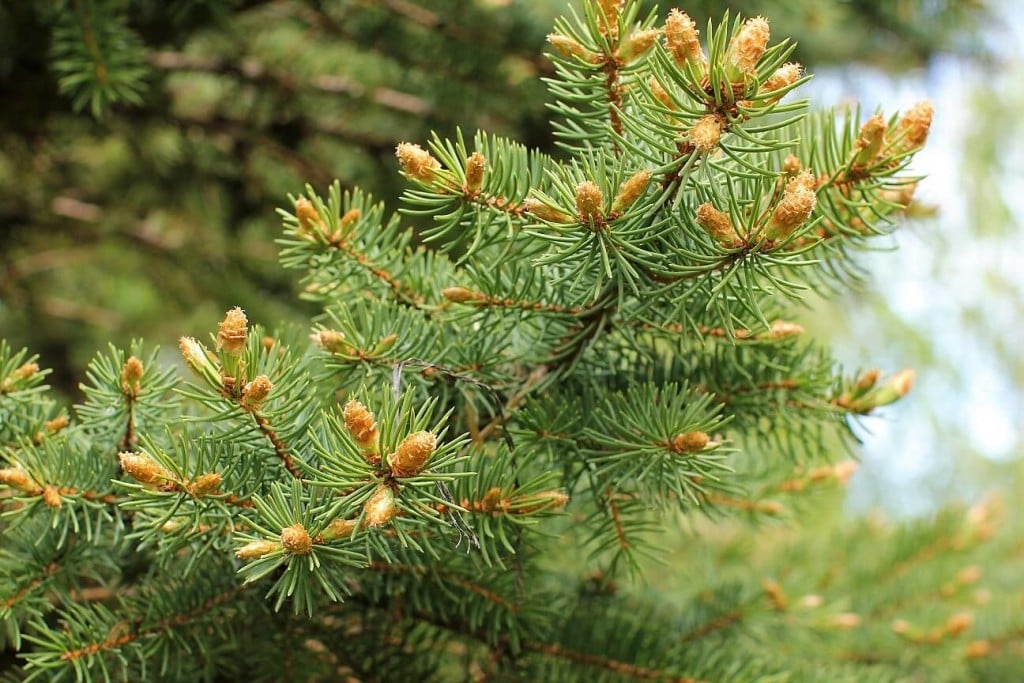
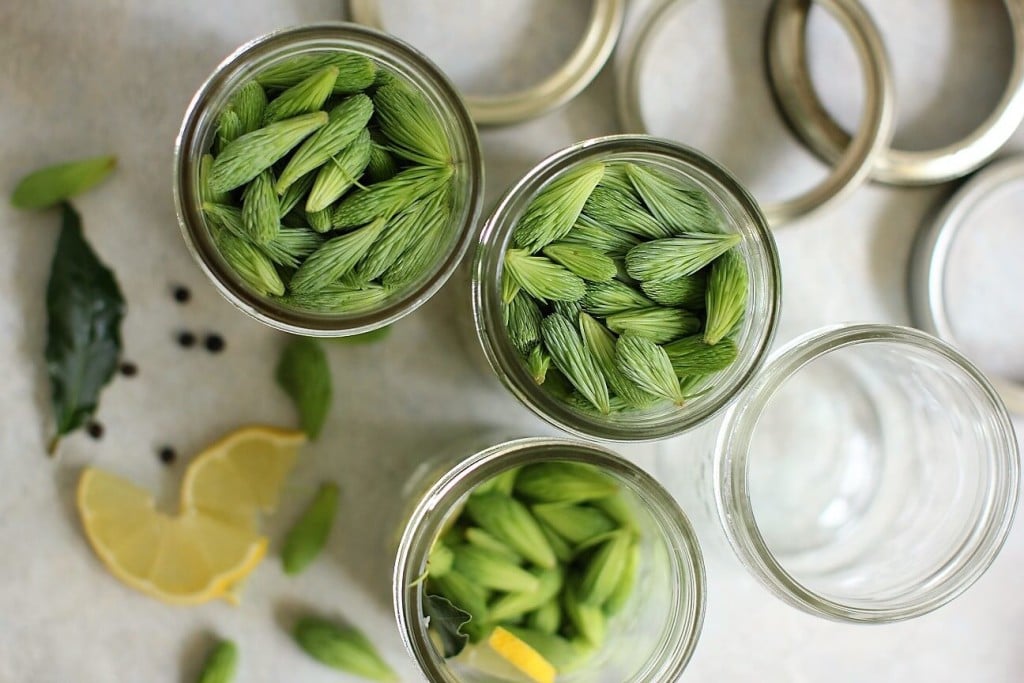
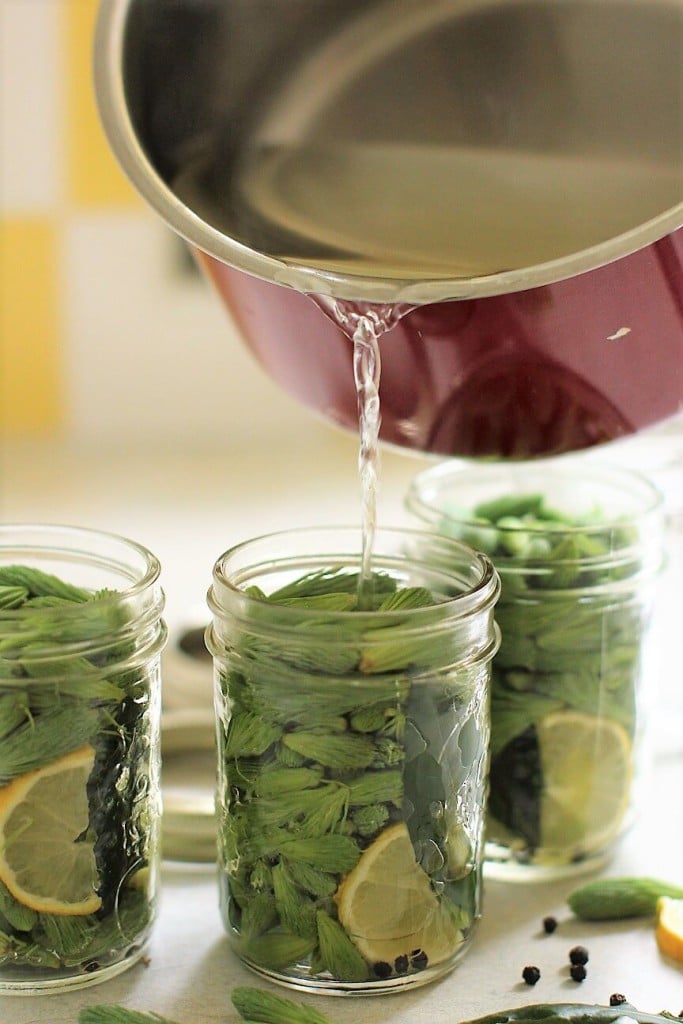
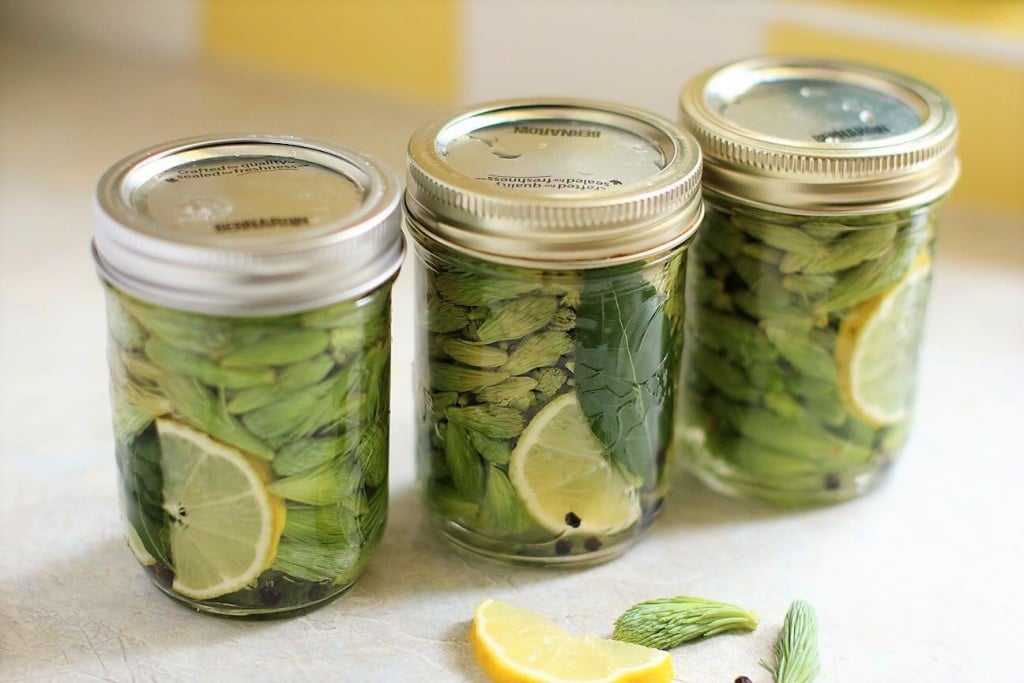
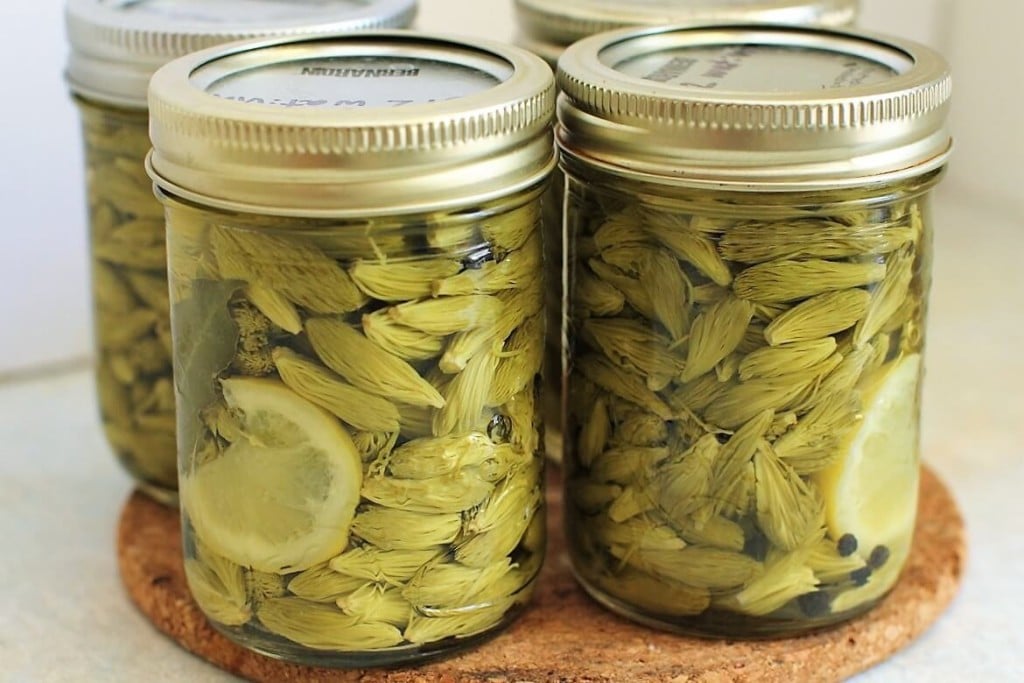

Maryann Borch
I love that this is so close to home, I hope to meet you out foraging some day! Come to Good Note Community farm if you want more good food!
Margaret
We live in a great area for foraging! I checked out your website - what a lovely place you have! I'd love to come visit some day.
leonalabine
tammy labine
Summer
I did this but added pickling salt, mustard seed, crushed red pepper and dark local honey and they are soooo good!!! Everyone that’s tried them loves them!
Margaret
Oh, yum, yum, yum! That sounds absolutely delicious! Thanks for the feedback 😍